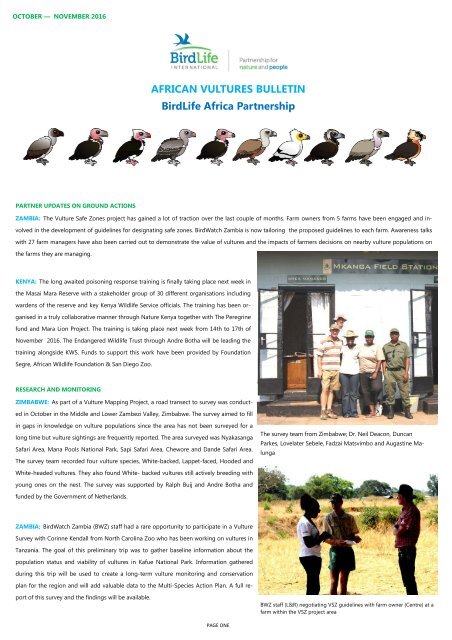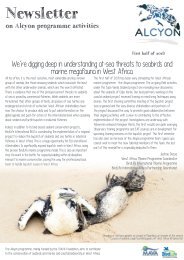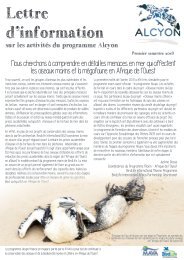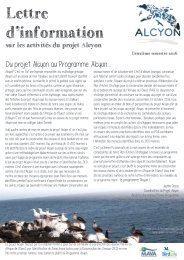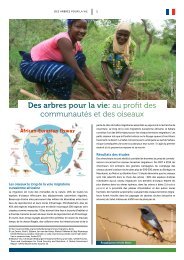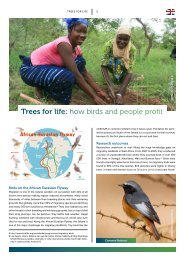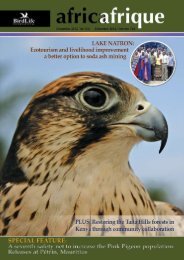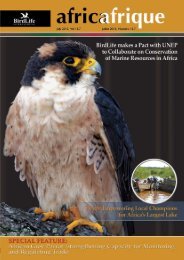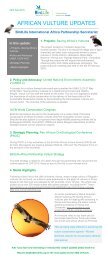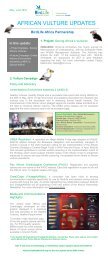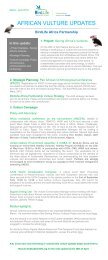You also want an ePaper? Increase the reach of your titles
YUMPU automatically turns print PDFs into web optimized ePapers that Google loves.
OCTOBER — NOVEMBER <strong>2016</strong><br />
AFRICAN VULTURES BULLETIN<br />
BirdLife Africa Partnership<br />
PARTNER UPDATES ON GROUND ACTIONS<br />
ZAMBIA: The Vulture Safe Zones project has gained a lot of traction over the last couple of months. Farm owners from 5 farms have been engaged and involved<br />
in the development of guidelines for designating safe zones. BirdWatch Zambia is now tailoring the proposed guidelines to each farm. Awareness talks<br />
with 27 farm managers have also been carried out to demonstrate the value of vultures and the impacts of farmers decisions on nearby vulture populations on<br />
the farms they are managing.<br />
KENYA: The long awaited poisoning response training is finally taking place next week in<br />
the Masai Mara Reserve with a stakeholder group of 30 different organisations including<br />
wardens of the reserve and key Kenya Wildlife Service officials. The training has been organised<br />
in a truly collaborative manner through Nature Kenya together with The Peregrine<br />
fund and Mara Lion Project. The training is taking place next week from 14th to 17th of<br />
<strong>November</strong> <strong>2016</strong>. The Endangered Wildlife Trust through Andre Botha will be leading the<br />
training alongside KWS. Funds to support this work have been provided by Foundation<br />
Segre, African Wildlife Foundation & San Diego Zoo.<br />
RESEARCH AND MONITORING<br />
ZIMBABWE: As part of a Vulture Mapping Project, a road transect to survey was conducted<br />
in <strong>October</strong> in the Middle and Lower Zambezi Valley, Zimbabwe. The survey aimed to fill<br />
in gaps in knowledge on vulture populations since the area has not been surveyed for a<br />
long time but vulture sightings are frequently reported. The area surveyed was Nyakasanga<br />
Safari Area, Mana Pools National Park, Sapi Safari Area, Chewore and Dande Safari Area.<br />
The survey team recorded four vulture species, White-backed, Lappet-faced, Hooded and<br />
The survey team from Zimbabwe; Dr. Neil Deacon, Duncan<br />
Parkes, Lovelater Sebele, Fadzai Matsvimbo and Augastine Malunga<br />
White-headed vultures. They also found White- backed vultures still actively breeding with<br />
young ones on the nest. The survey was supported by Ralph Buij and Andre Botha and<br />
funded by the Government of Netherlands.<br />
ZAMBIA; BirdWatch Zambia (BWZ) staff had a rare opportunity to participate in a Vulture<br />
Survey with Corinne Kendall from North Carolina Zoo who has been working on vultures in<br />
Tanzania. The goal of this preliminary trip was to gather baseline information about the<br />
population status and viability of vultures in Kafue National Park. Information gathered<br />
during this trip will be used to create a long-term vulture monitoring and conservation<br />
plan for the region and will add valuable data to the Multi-Species Action Plan. A full report<br />
of this survey and the findings will be available.<br />
BWZ staff (L&R) negotiating VSZ guidelines with farm owner (Centre) at a<br />
farm within the VSZ project area<br />
PAGE ONE
SOUTH AFRICA; BirdLife South Africa is investigating the possible impact of lead on South Africa’s bird species. Blood samples were taken from 4-5 month<br />
old White-backed Vulture chicks which could provide valuable clues as to the prevalence of lead toxicity in southern African vultures in particular. Photos:<br />
White backed vulture chick taken in South Africa during the blood sample collection, Right: Adult white-backed vulture.<br />
KENYA: In January <strong>2016</strong>, the Critical Ecosystem Partnership Fund, through BirdLife International, provided The Peregrine Fund (TPF) with a small grant to<br />
map and safeguard sensitive hotspots for threatened raptors/vultures in the Masai Mara National Reserve (MMNR) in Kenya. This Eastern Afro-montane Key<br />
Biodiversity Area (KBA) is a world famous tourist destination, but this seems to come at a cost. Since 2010, TPF has documented the abandonment of six<br />
nests of White-headed Vultures and at least 16 nests of White-backed Vultures at sites along the Talek and Mara rivers where new tourist camps have been<br />
constructed. With CEPF funding, TPF used Google Earth and ground surveys to intensively research five rivers in the Masai Mara where tourist establishments<br />
occur. They identified all permanent and mobile camps at these rivers, as well as areas where clusters of roosting and nesting raptors/vultures occur. This culminated<br />
in the production of a ‘raptor hot spots/raptor constraints map’ for the KBA. This map will now be used to develop a Conservation Strategy and<br />
Management Plan to safeguard these roosting and nesting sites.<br />
VULTURE CONSERVATION STRATEGY DEVELOPMENT AND IMPLEMENTATION<br />
CMS MsAP Workshop in Dakar:<br />
The CMS Africa Regional MsAP workshop took place from 18 – 21 <strong>October</strong> <strong>2016</strong> in Dakar, Senegal. There were a total of 45 workshop participants from 28 different<br />
countries around the world of which 19 African countries from 4 regions, North, East, South and West were represented. Central Africa was a gap. Southern<br />
Africa has the highest representation at the workshop with South Africa constituting the highest representation from any country.<br />
East Africa: Kenya, Uganda, Rwanda, Tanzania, Djibouti and Ethiopia.<br />
West Africa: Benin, Burkina Faso, Ghana, Guinea, Guinea-Bissau, Niger, Chad and Nigeria.<br />
North Africa: Morocco and Tunisia<br />
Southern Africa: Zimbabwe, Botswana, South Africa, Swaziland, and Angola.<br />
Participants were from a range of research institutions, Universities, NGO’s and Government.<br />
The workshop was facilitated by Chris Bowden, Globally Threatened Species Officer & SAVE Programme Manager, RSPB<br />
During the workshop, they identified and categorized the major threats facing Vultures in Africa and the outcome of the workshop will inform the African component<br />
which will be part of the global Multi Species Action Plan. A report will be shared with participants in in due course.<br />
POLICY AND LEGISLATION ACTIONS FOR VULTURES<br />
AFRICAN UNION: BirdLife has been reaching out to African partners to engage their national governments to put vultures on the agenda of the African Union<br />
Summit to be held next year in January. A draft resolution on illegal wildlife poisoning has been circulated to partners for comment to encourage governments<br />
to propose during the Summit, ensuring a tangible outcome from the AU engagement.<br />
UNCBD CoP: men BirdLife has secured a vulture side event on the 7th of December at the upcoming CBD CoP in Cancun, Mexico. The event will aim to highlight<br />
the importance of vulture conservation to their continued survival around the world and how conservation efforts align with achieving various Aichi biodiversity<br />
targets. BirdLife will partner with the IUCN Vulture Specialist Group, Convention on Migratory Species and Vulture Conservation Foundation. The event<br />
is being led by the BirdLife global secretariat.<br />
N.B: If you have any interesting or newsworthy vulture updates please send them to: Masumi.Gudka@birdlife.org<br />
PAGE TWO


